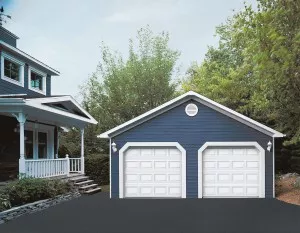As your family grows, you may notice that your original space no longer accommodates all of your belongings. Each member of your family needs living space and also adequate room to store his or her possessions. You also require convenient storage for extra appliances, vehicles, and equipment.
When you see your original garage overflow with belongings and you can no longer park your car inside, it may be time to consider an addition. A second garage gives you the storage space you need for your appliances or for additional vehicles without crowding the space.

As your family grows, you may notice that your original space no longer accommodates all of your belongings. Each member of your family needs living space and also adequate room to store his or her possessions. You also require convenient storage for extra appliances, vehicles, and equipment.
When you see your original garage overflow with belongings and you can no longer park your car inside, it may be time to consider an addition. A second garage gives you the storage space you need for your appliances or for additional vehicles without crowding the space.
However, before you make a significant investment, you must consider certain factors. Read on to discover five things you should think about before you call a contractor to install an additional building.
1. Size
Ask yourself about the main purpose of your new garage. Will it store your boat, skis, or other vehicles? Will it serve as a shed for your gardening tools? Or will you park a car there?
If you already have a two-car garage and you don’t plan to buy any more vehicles, you could use the second garage for small storage purposes. But if you expect your family to grow and you think you’ll need to invest in another car, you might want to leave enough space for future parking as well.
2. Zoning Laws
Ask your city or county for a list of housing regulations before you make any plans to install an additional structure. Then, take the time to measure your home and yard to make sure your plans follow local zoning laws. If you have to leave a required amount of space between your next door neighbor’s fence and your building, you may not have room to expand your garage space.
You should also consult your HOA for rules about exterior changes. Your cul-de-sac or gated community might have already decided on the maximum space allowed for buildings on your property.
If your plan for a new garage meets the required specifications, proceed with construction.
3. Road Access
Remember that you need to connect your new garage to the street. When you prepare to pave a new addition to your driveway, consider how much of your front or side yard it will cover. And to keep your vehicle and its tires in good condition, you should also look at the curb to see if you’ll need to change your gutters.
If you plan to install a two-car driveway, you’ll need at least 20 feet of width-more if you have overhanging trees or bushes. Talk to your contractor about the best use of space for your new driveway.
4. Proximity to the House
Depending on the size of your yard, you could place your additional garage right next to your existing garage. Or, you could create a free standing building on another part of your property.
If you choose to build a new unit right next to your house, inspect your exterior for potential problems. Will your new garage cover a wall with windows and doors? Do you have to move any electrical outlets or pipes to accommodate your new garage? Take inventory of the situation and ask your contractor to factor these items into your final cost estimate.
For a free standing garage, place it behind your home or a few feet away from the edge of your house. Carefully consider what you will do with the space between the two buildings. How will you maintain your landscaping? Is there a clear pathway between your house and your garage? Will you have to move any trees or plants that stand in the way?
When you plan ahead and take into account the challenges that each model poses, you won’t feel surprised at the final cost. This method also prepares you to make changes to your plans if your original idea doesn’t fit your yard’s layout.
5. Garage Door Options
Your new garage needs a garage door so you can access the interior. After you consider all other factors, decide which garage door option fits your needs best. Do you want an automatic garage door? What size door will match the building’s aesthetics?
You should also think about how the door for your new garage will complement current garage door. Do you want to have identical doors for both buildings? If so, you’ll need to find out if your original garage door supplier is still around-and if they still offer the same models and colors they did when you first purchased your door.
If you can’t find the same company, you’ll have to invest in two garage doors to maintain a coherent style throughout your property. Take advantage of this opportunity to update both garage doors to the latest styles and security for your home. But if matching colors and styles don’t rank high on your priority list, purchase a new garage door company to find what you have in mind.
When you keep these five factors in mind, you can envision all aspects of your second garage before you sign a contract or make a single payment. Remember to talk to your contractor or garage door installation company for any additional questions or concerns you have.

Add new comment